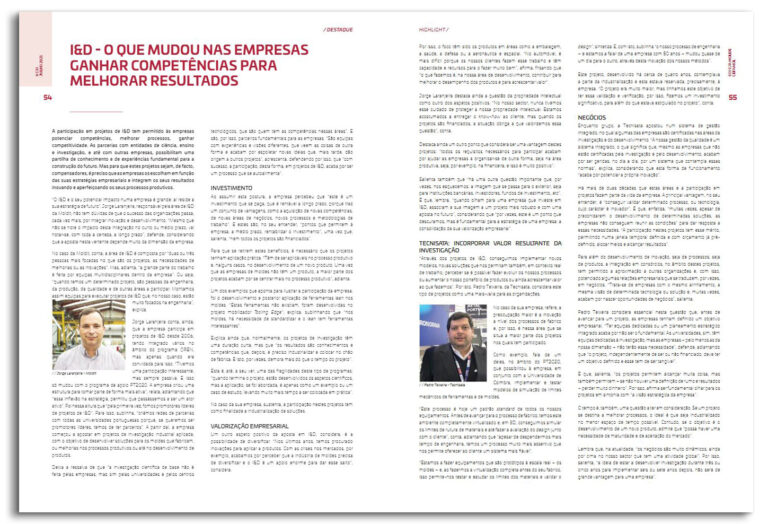- TECNISATA IN THE ARTICLE: "R&D - WHAT CHANGED IN COMPANIES" -
- TECNISATA IN THE ARTICLE: "R&D - WHAT CHANGED IN COMPANIES" -
-
"
- Through R&D projects, we are able to implement new models, new solutions that also allow us, in a real work context, to see if it is possible to evolve our processes or increase our product portfolio or even add value to what we do." By this, Pedro Teixeira, from Tecnisata, considers this type of project as an asset for organizations. In the case of his company, he says, the greatest concern is innovation in terms of manufacturing processes and, therefore, it is in this area which is located in most of the projects in which he has participated.
As an example, he talks about one of them, within the scope of PT2020, which enabled the company, together with the University of Coimbra, to implement and test simulation models of the mechanical limits of tools and molds. - "This process is now a standard standard for all our equipment. Before moving on to the manufacturing process, we have this environment completely virtualized and, in 3D, we were able to simulate the material breakage limits and even make the design evaluation together with the customer", he says, adding that "despite spending more time on engineering, we have a much more assertive process that allows us to offer the customer a more reliable system".
- "We are making equipment that are prototypes on a full scale - the molds - and, by doing the complete virtualization before their manufacture, this allows us to test and study the limits of the materials and validate the design", he sums up. And with that, she underlines "our engineering process-and we're talking about a 50-year-old company that changed almost overnight, through this innovation in our methods."
- This project, developed about four years ago, contemplated the industrialization part and this was reserved, precisely, for the company. "The project was much bigger, but we had this objective of having this validation and verification, so we made a significant investment, in addition to what was stipulated in the project", he says.
- BUSINESS
- As a group, Tecnisata invested in an integrated management system, in which some of the companies are certified in the areas of research and development. "Our quality management is an integrated system, which means that even companies that are not certified by research and development end up being managed, on a daily basis, by a system that includes these standards", he explains, considering that this way of functioning "ends up promoting the innovation itself".
For over two decades these areas and participation in projects have been part of the company's life. The main advantage, in his opinion, is "being able to validate a certain process, or technology, whose character is innovative". He emphasizes that "often, despite advocating the development of certain solutions, companies are unable to meet the conditions" to respond to these needs. "Participation in these projects has this merit, allowing a defined time window and with a pre-defined budget, allocating resources and achieving results". - In addition to the development of innovation, whether in processes or products, the integration in consortia, within the scope of these projects, has allowed the approach to other organizations and, with this, enhanced some business relationships that sometimes translate into business . "These are companies with the same alignment, the same vision of a certain technology or solution and, many times, business opportunities end up being created", he emphasizes.
- Pedro Teixeira considers it is essential in this matter that, before moving on to a project, companies have defined a business objective. "Having dedicated teams or integrated strategic planning turns out not to be essential. Universities have teams dedicated to research, but companies - at least those of our size - will not have this need", he argues, adding that "the project, independently whether it is financed or not, it must have a defined objective and this must be tangible".
- The fact is that, he points out, "projects allow us to achieve a lot, but they also allow - if there is no definition of direction and results - to lose a lot of money". For this reason, he claims that it is essential to look at projects in line with "the company's strategic vision".
- Timing is also an issue to be taken into account. If a project is intended to improve processes, ideally it should be industrialized in the shortest possible time. However, if the goal is the development of a new product, he admits that "there may be a need for maturity and acceptance in the market".
- He recalls that currently "business is very dynamic, especially in our sector, which has a global activity", so he stresses "the idea of carrying out research for three or five years to implement six or seven years later, no it will be of great advantage to a company.
-
"
-
- 22/09/2021
